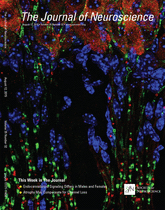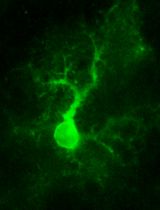- EN - English
- CN - 中文
Measurement of Inositol Triphosphate Levels from Rat Hippocampal Slices
大鼠海马脑片中肌醇三磷酸含量测定
发布: 2016年04月05日第6卷第7期 DOI: 10.21769/BioProtoc.1780 浏览次数: 8942
评审: Oneil G. BhalalaManuel D. GaheteKae-Jiun Chang
Abstract
Inositol triphosphate (IP3) is an important second messenger that participates in signal transduction pathways in diverse cell types including hippocampal neurons. Stimulation of phospholipase C in response to various stimuli (hormones, growth factors, neurotransmitters, neurotrophins, neuromodulators, odorants, light, etc.) results in hydrolysis of phosphatidylinositol 4, 5-bisphosphate (PIP2), a phospholipid that is located in the plasma membrane, and leads to the production of IP3 and diacylglycerol. Binding of IP3 to the IP3 receptor (IP3R) induces Ca2+ release from intracellular stores and enables the initiation of intracellular Ca2+-dependent signaling. Here we describe a procedure for the measurement of cellular IP3 levels in tissue homogenates prepared from rat hippocampal slices.
Keywords: Hippocampus (海马)Materials and Reagents
- Syringes (1 ml and 60 ml) and needles (24 and 27 gauge) (Becton Dickinson, catalog numbers: 309659 and 309653 )
- Single edge razor blade (IDL TechniEdge, catalog number: 05-091C )
- Double edge razor blade (Electron Microscopy Sciences, catalog number: 72002-10 )
- Costar Netwell Insert with 440 μm polyester mesh (Corning, catalog number: 3478 )
- Corning assay plate, black 384 well with non-binding surface (Corning, catalog number: 3575 )
- Conical tube (15 ml) (BD Biosciences, catalog number: REF352196 )
Note: Currently, it is “Thermo Fisher Scientific, FalconTM, catalog number: REF352196”. - Micro-centrifuge tubes (1.5 ml) (VWR International, catalog number: 20170-038 )
- Aerosol barrier pipette tips (30 μl and 200 μl) (Thermo Fisher Scientific, catalog numbers: 02-707-33 and 02-707-42 )
- Disposable transfer pipette (Thermo Fisher Scientific, catalog number: 13-711-9AM )
- Glass plate (Electron Microscopy Sciences, catalog number: 70312-22 )
- Glass staining dish (Newcomer supply, catalog number: 6816A )
- Coarse fritted glass bubbler (Corning, catalog number: 39533-12EC )
- Integrid Petri dishes (Becton Dickinson, Falcon, catalog number: 351112 )
Note: Currently, it is “Thermo Fisher Scientific, FalconTM, catalog number: 351112 ”. - Adult (47-57 days old) male and female Sprague Dawley rats (Harlan Laboratories)
- Hit-Hunter IP3 fluorescence polarization assay kit (DiscoveRx Corporation, catalog number: 90-0037 )
- 70% Perchloric acid (HClO4) (Sigma-Aldrich, catalog number: 244252 )
- Complete protease inhibitor cocktail tablets (Roche Diagnostics, catalog number: 11697498001 )
- Quick Start Bovine Serum Albumin (BSA) standard (Bio-Rad Laboratories, catalog number: 500-0206 )
- Protein assay reagent (Bio-Rad Laboratories, catalog number: 500-0006 )
- Sodium pentobarbital solution (Virbac, catalog number: 710101 )
- Calcium chloride solution (CaCl2) (Sigma-Aldrich, catalog number: 21115 )
- Magnesium chloride solution (MgCl2) (Sigma-Aldrich, catalog number: M1028 )
- Super glue (Super Glue Corporation, catalog number: SGP3 )
- 70% ethanol (Thermo Fisher Scientific, Decon labsTM, catalog number: 04-355-305 )
- 95% O2/5% CO2 gas mixture (Airgas, catalog number: X02OX95C2003102 )
- NaCl
- NaHCO3
- Dextrose
- KCl
- NaH2PO4
- HEPES (pH 7.4)
- EGTA
- Sodium orthovanadate
- NaF
- Sodium pyrophosphate
- PMSF
- Artificial cerebrospinal fluid (aCSF) (see Recipes)
- Sucrose aCSF (s-aCSF) (see Recipes)
- HEPES homogenization buffer (see Recipes)
Equipment
- Scissors (Fine science tools, catalog numbers: 14000-12 and 14060-10 )
- Forceps (Stoelting, catalog numbers: 52104-37 and 52104-35 )
- Hemostat (Fine science tools, catalog number: 13008-12 )
- Spatula (Thermo Fisher Scientific, catalog number: S50822 )
- Accuspin micro 17R microcentrifuge (Thermo Fisher Scientific, catalog number: 13-100-676 )
- Biophotometer (Eppendorf AG, catalog number: 6133000010 )
- Leica VT1200S vibrating blade microtome (Leica Biosystems Nussloch GmbH, catalog number: 1491200S001 )
- Isotemp 105 water bath (Thermo Fisher Scientific, catalog number: S63077Q )
- Qsonica Q500 sonicator (Thermo Fisher Scientific, catalog number: 15-338-282 )
- Synergy 4 multimode microplate reader (BioTek Instruments)
- Vapor pressure osmometer 5520 (Wescor)
- Accumet AB15 plus pH meter (Thermo Fisher Scientific, catalog number: 13-636-AB15PC )
- Rotator (Labline Instruments)
- Micropipettes (2-20 μl, 20-200 μl and 100-1,000 μl) (Capitol Scientific, Eppendorf, catalog numbers: 3120000038 , 3120000054 and 3120000062 )
Procedure
文章信息
版权信息
© 2016 The Authors; exclusive licensee Bio-protocol LLC.
如何引用
Readers should cite both the Bio-protocol article and the original research article where this protocol was used:
- Tabatadze, N. and Woolley, C. (2016). Measurement of Inositol Triphosphate Levels from Rat Hippocampal Slices. Bio-protocol 6(7): e1780. DOI: 10.21769/BioProtoc.1780.
- Tabatadze, N., Huang, G., May, R. M., Jain, A. and Woolley, C. S. (2015). Sex differences in molecular signaling at inhibitory synapses in the hippocampus. J Neurosci 35(32): 11252-11265.
分类
神经科学 > 细胞机理 > 胞内信号传导
生物化学 > 其它化合物 > 糖醇
您对这篇实验方法有问题吗?
在此处发布您的问题,我们将邀请本文作者来回答。同时,我们会将您的问题发布到Bio-protocol Exchange,以便寻求社区成员的帮助。
Share
Bluesky
X
Copy link












